24 terms were found.
(Also: view all shapes in a table, ordered alphabetically or by grouped by shape or type)
| Term | Definition |
| CORDIFORM | Heart shaped, as in the bivalve Corculum cardissa. See also: CORDATE. | |
| DONACIFORM | A form of TRIGONAL shape exemplified by the BIVALVE genus Donax. See other bivalve shapes. | |

|
| ELLIPTICAL |
Like an ellipse or flattend oval; see also: ELONGATE ELLIPTICAL. See other bivalve shapes |
|

|
| ELONGATE |
Lengthened; extended in one dimension. Illustration: Solen sp. See also: ENSIFORM; LINGUIFORM. See other bivalve shapes. Photo: Tagelus divisus (Spengler, 1794) |
|
 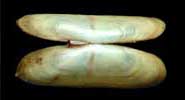
|
| ELONGATE ELLIPTICAL |
A basically ELLIPTICAL shape that has been elongated; like a flattened oval. See other bivalve shapes. |
|

|
| EQUIVALVE |
In bivalves, having each VALVE equal in size and shape; see also: EQUILATERAL; INEQUIVALVE. See other bivalve shapes. |
|

|
| FAN SHAPED |
A CLAM (bivalve) shape exemplified by the bivalve genus Atrina. See other bivalve shapes. Photo: Atrina rigida (Lightfoot, 1786) |
|
 
|
| INEQUIVALVE |
In bivalves, having one valve that is larger (as in the genera Anadara and Corbula) or more convex (as in the genus Pecten) than the other valve. See also: EQUIVALVE; MARGIN, DISCORDANT. See other bivalve shapes. Photo: Anadara brasiliana (Lamarck, 1819) |
|
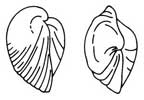 
|
| MYTILIFORM |
Shaped like the shell of the genus Mytilus. See other bivalve shapes. Photo: Modiolus modiolus (Linne, 1758) |
|
 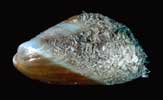
|
| NUCULANIFORM | A shape exemplified by the bivalve genus Nuculana; = ROSTRATE. See other bivalve shapes. | |

|
| ORBICULAR | Circular and flattish; see also: SUBORBICULAR. See other bivalve shapes. | |
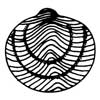
|
| OVAL |
Like a circle that has been somewhat flattened; see also: OVATE; SUBOVAL. See other bivalve shapes. |
|

|
| PECTINATE |
A shape exemplified by the bivalve genus Pecten. see also: BIPECTINATE; MONOPECTINATE. See other bivalve shapes. |
|

|
| PTERIIFORM |
A shape exemplified by the bivalve genus Pteria. See other bivalve shapes.
Photo: Pteria colymbus (Roding, 1798) |
|
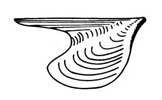 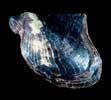
|
| QUADRATE |
Square or rectangular in general outline; applied to the outline of shells which is formed by nearly straight lines meeting at approximately right angles; see also: HEXAGONAL; POLYGONAL; OCTOGONAL; RHOMBOID; SUBQUADRATE; TRAPEZIFORM; TRAPEZOIDAL. See other bivalve shapes. Photo: Mysella sp. undet. |
|
 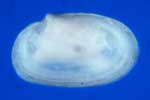
|
| ROSTRATE | Having a beak-like projection (as in a long, straight SIPHONAL CANAL, e.g. Cuspidaria spp.); = NUCULANIFORM; see also: BEAK. See other bivalve shapes. | |

|
| SUBELLIPTICAL | [need definition]. See other bivalve shapes. | |

|
| SUBORBICULAR | Having a shape of a misshapen circle; see also: ORBICULAR. See other bivalve shapes. | |

|
| SUBOVAL |
Like a circle that has been only slightly flattened; see also: OVAL; OVATE. See other bivalve shapes. |
|

|
| SUBQUADRATE |
Not quite QUADRATE, but nearly so; see also:
SUBELLIPTICAL. See other bivalve shapes. |
|

|
| SUBTRIGONAL |
Not quite TRIGONAL, but nearly so. See other bivalve shapes. Photo: Nucula proxima Say, 1822 |
|
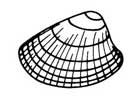 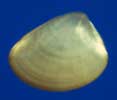
|
| TEREDINIFORM |
A shape exemplified by the SHIPWORM bivalve genus Teredo. See other bivalve shapes. Illustration: Teredo sp. (left = entire animal; center = PALLETS; right = shell) |
|

|
| TRIGONAL |
Having three sides and angles; triangular in outline; see also: TRIANGULATE; DELTOID; DONACIFORM. See other bivalve shapes. Photo: Parastarte triquetra (Conrad, 1846) |
|
 
|
| TRIGONALLY SUBOVAL | Having features of being triangular and somewhat OVAL in shape. See other bivalve shapes. | |

|